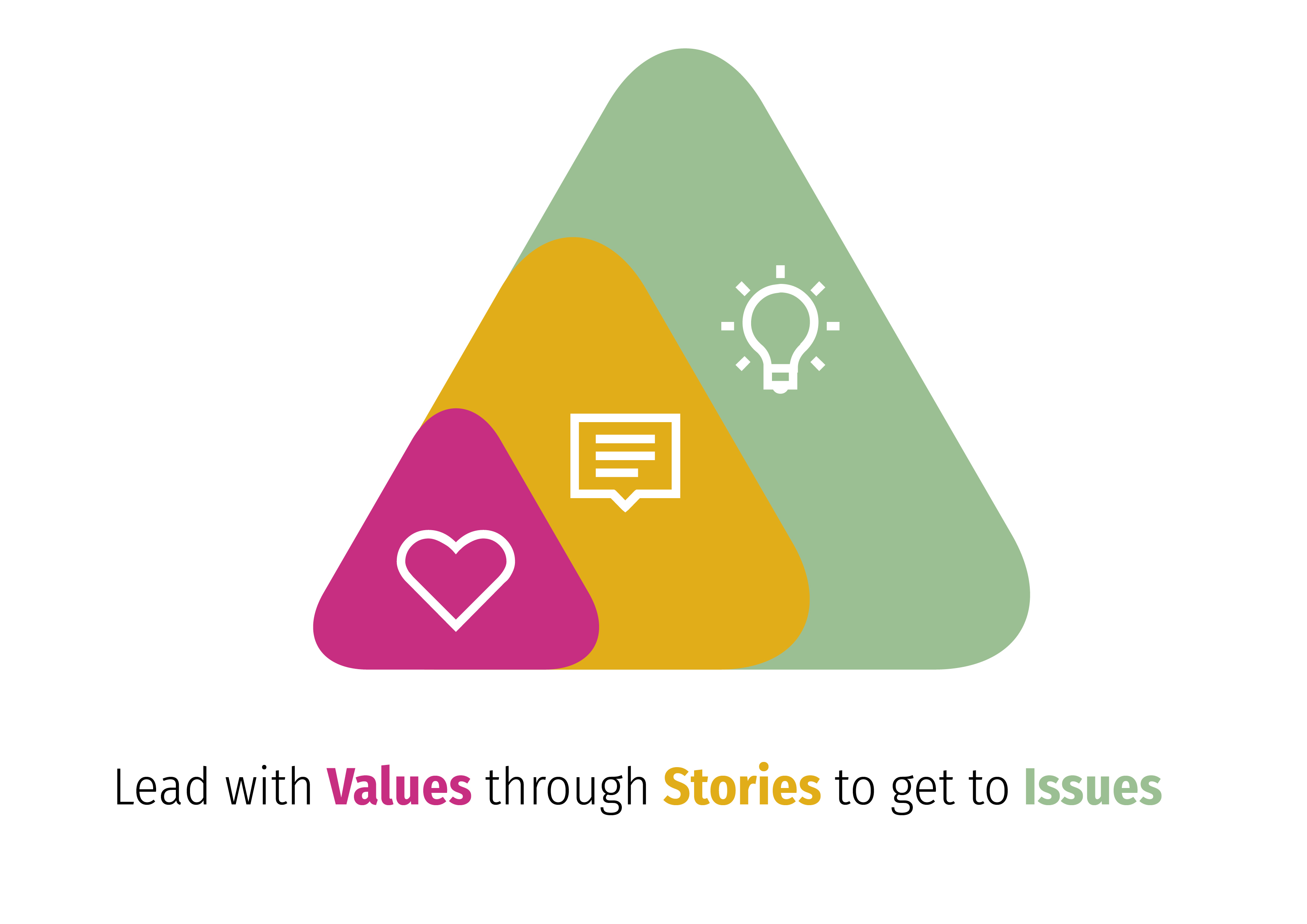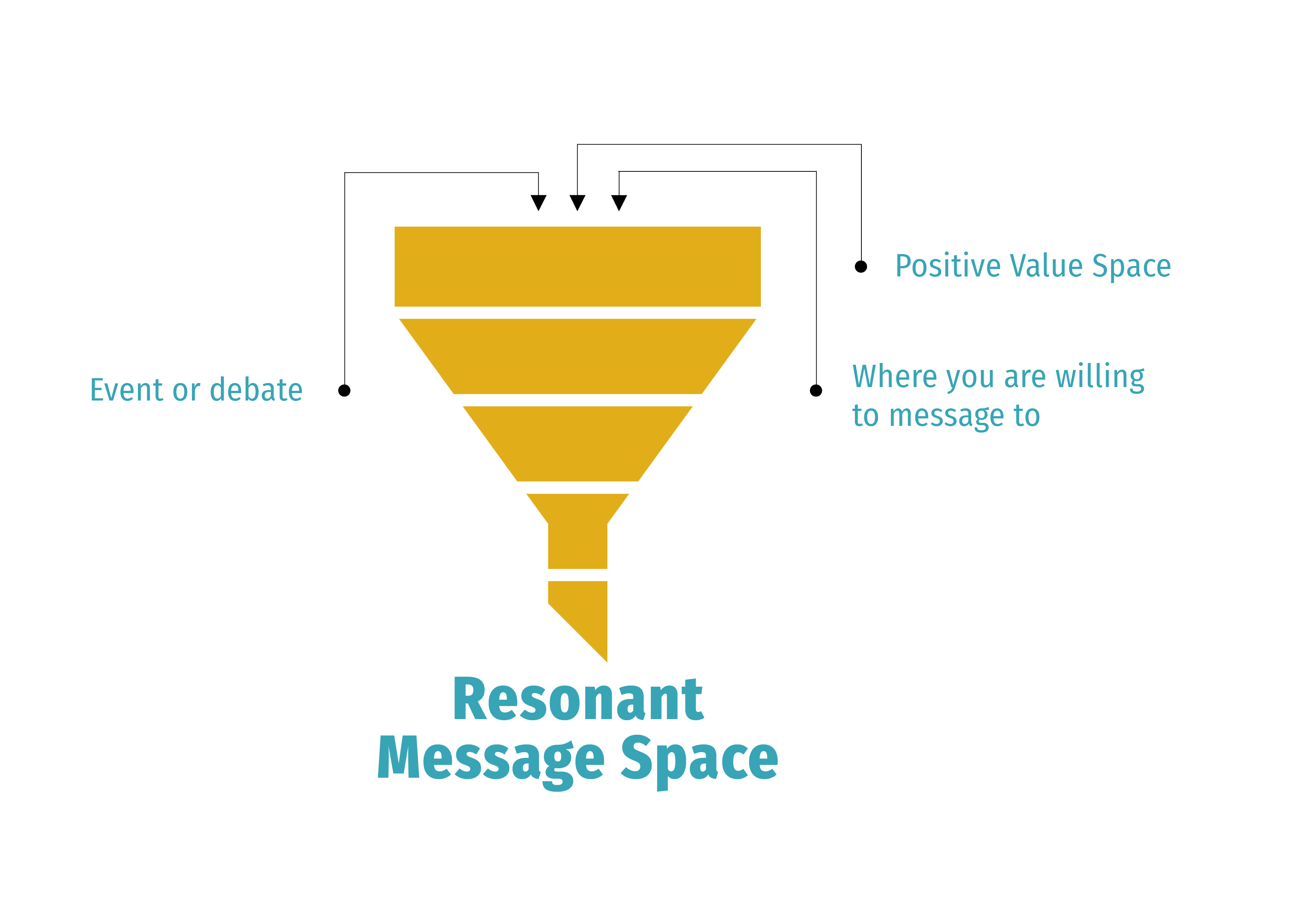Lesson 5: Anchor narratives in unifying values
Essence
Developing narratives around unifying values establishes a shared connection with target segments. Starting on common ground then serves as an emotionally smart bridge to open a conversation focused on building support for the work of civil society.
Insight
When targeting audiences who are sceptical or apathetic about the role, work and value of civil society, you can effectively build a connection by starting on common ground and leading with messages based on shared values. Such values-led narratives that also layer in shared aspirations and challenges can effectively build a resonant connection with such audiences. Further, when combined with humanising stories that bring your values to life, they build interest and open the door to a constructive debate on the issues. This framework underpins much of ICPA’s narrative change work, and is synopsised in Figure 7 below.

Figure 7 - The values-led intervention logic in ICPA’s narrative change approach
In contrast, issue-led approaches that tend to focus solely on facts, rights and expertise are not as engaging for middle groups and can even backfire1
. As anxiety and frustration are key features of polarised debates, this value-led strategy recognises the need for an emotionally- smart way to open a constructive debate, which offers a good chance to shift attitudes. We synopsise this point in one of our narrative change keys: “Values unite, issues divide”. However, it is important to point out that you will get to the discussion of evidence and rights; it’s a matter of effectively sequencing the communication.
Finding this common ground to open debates is of particular importance to CSOs as much of their work doesn’t have public presence, especially the work of those focused on supporting and promoting the rights of marginalised communities who are not so visible2
. Further, beyond countries where many CSOs are large-scale service providers, the work of the sector is not well understood by the public (see lesson 4). Unfortunately, these factors make the sector relatively easy to attack! It also should motivate advocates to work on raising awareness and building the profile and presence of the sector as a key social actor among the general public. It’s time to recognise that this is ongoing and proactive communications work, not just a one-off ad hoc campaign, which should start well before just as or after a crisis hits, as emphasised in Lesson 1 and also in our proposal for a proactive strategic communications strategy (See Section 5).
Cases
Action
- Define a resonant, overlapping and unifying value space for a campaign targeting specific middle segments: We and many of our partners use the following funnelling tool to guide this process of coming to a resonant messaging space. For guidance on conducting such a funnelling process, see our Reframing Migration Narratives Toolkit, including an easy to use template to complete your own positive values mapping.

Figure 8: Process to identify campaign value appeals shared with the target audience (from ICPA toolkit)
- Work from problem or issues to values: A second tool that has worked well for campaigners we’ve supported entails writing down the specific problems or issues faced, and then identifying the values associated with these issues that might be useful to leverage to engage the target audience. This is an approach developed by Anat Shenker-Osorio4 and uses the example that was effective for the LGBT+ movement in many countries once it moved away from a discussion of rights in public campaigning towards embracing the values of family and commitment. She suggests replacing problems and embracing values as the basis of your argument. Below are three examples of civic space problems and how they might be tackled in a value-led approach:
| Replace problem | Embrace Values |
| Public vilification as traitor | Fairness, free speech, protection from defamation |
| Restrictions on foreign funding | Growth and development targets |
| Burdensome reporting requirements | Rule of Law & efficiency of public processes |
Also see Lesson 7 on wedge issues as yet another way to find shared concerns and values.
What you can get wrong
- Trying to please the middle segment, rather than building a foundation for authentic engagement that can shift attitudes: It’s not enough to just pick values that you know will work for the target group, but don’t actually work for you and your organisation! If you find a good overlap in values, you can be authentic through all stages of campaigning and discussions. It’s evident in seconds to the target audience when a messenger/campaigner is just trying to please them, as the lack of enthusiasm and authenticity is palpable! A second problem with a ‘people pleasing’ approach is that there is no dissonance, i.e. there’s no challenge to the target audience’s prejudices or stereotypes. Creating opportunities for your target audience to question current mindsets and change attitudes is a key ingredient for the values-based approach.
- 1ICPA (2018) Reframing Migration Narratives Toolkit: Understanding The Power of Frames
- 2Israel Butler, Liberties (2021) How to talk about civic space: a guide for progressive civil society facing smear campaigns
- 3MediaNet (2021) Azamatbol Campaign Facebook Page
- 4Anat Shenker-Osorio, Centre for Community Change (2016) Messaging This Moment: A Handbook for Progressive Communicators